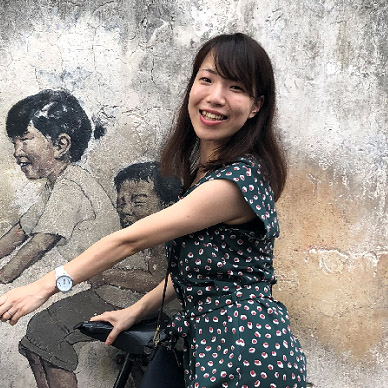
Dr Aki GOTO
Doctoral student
The University of Tokyo
Aki Goto is a third-year doctoral student at the University of Tokyo and a researcher in Japan Aerospace Exploration Agency (JAXA, 2015-current). Her work focuses on the reactions of polymeric materials with atomic oxygen (AO), which is a hazardous residual gas for polymers in low Earth orbit (LEO) space environment. She investigated polymers’ reactions with AO by analyzing various samples exposed to LEO environment on the ISS and Super Low Altitude Test Satellite (SLATS). In her doctoral dissertation titled “Study on Microstructures on Surfaces of Hydrocarbon Polymer Films by Atomic Oxygen Irradiation,” she examines the phenomena that AO forms nanoscale protrusions on polymer surfaces, to apply AO irradiation techniques for surface modification. Her research is supported by Inamori Foundation and Japan Society for the Promotion of Science (JSPS). She holds a Bachelor of Science in chemistry and a Master of Science in macromolecular science from Osaka University.
Study on Microstructures on Surfaces of Hydrocarbon Polymer Films by Atomic Oxygen Irradiation
Low Earth orbit (LEO) is important for Earth observations and communications. Atomic oxygen (AO) is a dominant constituent of the residual atmosphere in an LEO (at an altitude of 200–700 km) and collides with spacecraft at a relative velocity of 8 km/s. Polymers used for thermal control are oxidized and eroded by the AO collisions, degrading their thermo-optical and mechanical properties. To ensure successful spacecraft missions, evaluating polymers’ durability against AO is necessary. AO forms nanoscale protrusions on polymer surfaces in the erosion process. If the surface morphology and properties (wettability, optical property) can be determined by AO irradiation, AO might be useful in modifying the surface for a polymer. However, dominant factors and mechanisms for the morphological change have not been known. This study aims to clarify the mechanism for microstructure formation on polymers by AO irradiation. Three hydrocarbon polymers were selected: polyethylene (PE), polypropylene (PP), and polystyrene (PS). The mass losses, changes in morphologies and chemical bonds were investigated after AO irradiations. The surfaces were also analyzed by positron annihilation lifetime spectroscopy (PALS) to see the effects of polymer’s higher-order structures. PE, PP, and PS had similar mass losses and changes in chemical bonds; however, the formed protrusions’ shapes (sizes and numerical density) differed each other. The PALS measurements indicated that the difference in higher-order structures affects the spatial scale where AO reacts with a polymer, which would lead to the morphologies. The results will contribute to the developments of a surface modification method and AO protective materials